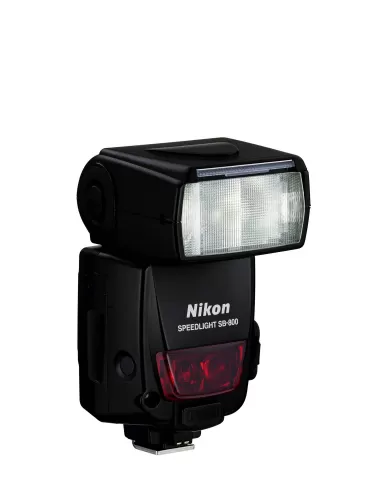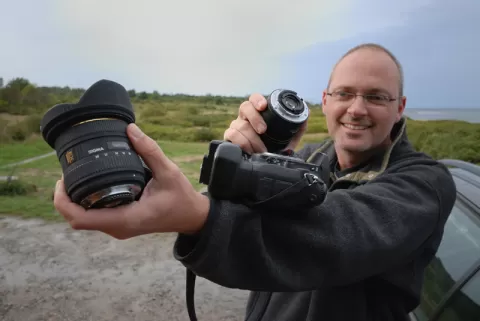I'm still learning to know Nikon's flagship
My experience with flashes has told me: buy big! When it comes to extra light you need what you can get, and nothing but the largest flash in the Nikon series seemed to be able to do it.
So I acquired a Nikon SB-800, which is able to get the best from the new digital cameras. It does a swell job as far as I can see. I have already shot some great dusk pictures using the slow rear function, which is a really nice way of avoiding the worst thing about flashes: lighting up a whole scene. Flash images generally stink because people use them as their sole source of light. That's not good! Read why here.
So the SB-800 has done well so far, but I haven't nearly pressed it as hard as I could. I want to test the "wireless" mode, where it acts as an intelligent slave to the built-in flash, not really wireless like the Minolta HS5600, which does not need the built-in flash to be popped.
You won't need a separate controller because the Nikon system controls through ultra-short preflashes. I'm gonna miss the "real" wireless feature. I also find the controls of the SB-800 a bit on the primitive side as is the display on the backside. Now, this is not a cheap piece of toy. This flash costs more than some people want to pay for a whole camera, so I think a bit more could be expected.

[D200, Sigma 10-20mm, SB800]
Menu menace
While the results with the SB-800 are generally very good and the flash does what it's supposed to -- and very well -- the design of the user-interface and controls simply stinks!
The engineers who designed the two should look at the user-interface on Nokia Phones and peek at the design of
While the design of the flash itself is fairly elegant and sleek, the controls and the graphics on the display are kludgy and downright ugly. The buttons have been cast in some translucent plastic, which seems a good idea since the light from the flash can shine through them, enabling the user to see them in the dark. But the clear material and the clumsy and hard-to-understand symbols just doesn't cut it. And while the central control is overly large and rough, the small buttons -- Mode and on/off -- are small, recessed and hard to get to.
The graphics on the display are equally badly designed and are generally primitive and not exactly pretty. I know there are limitations on a B/W LCD-display, but things can actually be designed well within the limits, and the option of a higher resolution display has also been there. Comparing to modern color displays on the back of the cameras makes this look like stoneage technology.
Combine that display and the clumsy buttons with a terrible user-interface and you have a looser. Changing modes on this flash -- like from standard TTL to slave -- requires many pushes on various buttons. The sequence is not easy to remember, and the symbols do not help that much. Try to turn on or off the sound -- yes, it has audio feedback. Not an easy task without the manual. Actually it's not even easy with the manual at hand.
Considering the access to nice, modern displays and the easy-to-use menu systems of even very complex cameras, it's amazing how Nikon could bring themselves to equip this expensive, top-of-the-line flash with such primitive set of controls.
As I said: I'm glad it takes such great pictures. That's the only reason I (almost) forgive the interface.

[D200, Sigma 10-20mm, 2xSB800]
Wireless and cable
The SB-800 can work wireless -- or rather remotely triggered. The triggering is done with the help of the built-in flash (or a second SB-800 if you can afford it), and works through the emission of a series of very short bursts from the master or controller flash, which is attached to the camera. Thes bursts form a code, which the remote flash or flashes use to dose their light. This enables you to place one or several flashes quite far from the camera and still use TTL-measurement to control the amount of light they emit. If you can afford it, the D200 can actually control several SB-800's organized in groups and controlled in great detail.
My personal experiments with this has led to some disappointment. I see way too much of the light from the controller flash in the images. I use the pop-up flash as the master, and that will always emit a straight-on flat light. I tried turning the internal flash down by underexposing it, but I still see it fairly clearly in my images.
That has led to the acquisition of an SC-29 flash cable, the leatest and greatest of Nikon's cables for off camera flash use. There are some other models too -- the old grey SC-17 cable and the newer SC-28 -- but the one I bought is the current top-of-the-line. These cables are huge, thick, stiff and expensive, but really nice since they transfer all flash info to the camera and enable as complete and precise control as if the flash was on the camera. The SC-29 even has a built-in AF-illuminator that can be turned on to replace the one on the flash in case the flash is not pointed towards the subject.
I have used the cable quite a bit now, and I'm very pleased with the results. I have even built a small softbox for my SB-800 and the cable and box in combination gives some really nice exposures, particularly in close-ups.




